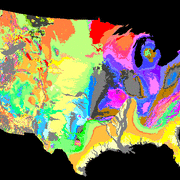Core Science Systems
Home
CSS leads USGS’s mission as the civilian mapping agency for the Nation. We conduct detailed surveys and develop high quality, highly accurate topographic, geologic, hydrographic, and biogeographic maps and data. Our maps allow precise planning for critical mineral assessments; energy development; infrastructure projects; urban planning; flood prediction; emergency response; and hazard mitigation.
National Geospatial Program

The National Geospatial Program is the Federal civilian mapping agency and provides the digital geospatial foundation for the Nation. It engages partners and communities of use to collaboratively produce consistent and accurate topographic map data.
Learn MoreScience Analytics and Synthesis (SAS)

The USGS Science Data Catalog, supported by SAS, provides seamless access to USGS research and monitoring data from across the nation. Users have the ability to search, browse, or use a map-based interface to discover data.
Learn MoreNews
Favorite Headstones and Mapping
The National Map Corps encourages and leverages volunteer citizen scientists to update structure data to The National Map. To reward, recognize and motivate these participants, the program awards “virtual” badges for increasing levels of edits and submission.
USGS Topo Base Map Refreshed and Other Updates
The “USGS Topo Base Map” service named “USGS Topo” has been refreshed with new data and design changes. In addition, several of the “Data Availability”, or “Data Index” services have new cloud hosted URLs.
Celebrating Geologic Map Day 2018
In celebration of Earth Science Week and Geologic Map Day, the USGS National Cooperative Geologic Mapping Program is highlighting several exciting ongoing and upcoming geoscience-related activities:
Publications
Automated road breaching to enhance extraction of natural drainage networks from elevation models through deep learning
High-resolution (HR) digital elevation models (DEMs), such as those at resolutions of 1 and 3 meters, have increasingly become more widely available, along with lidar point cloud data. In a natural environment, a detailed surface water drainage network can be extracted from a HR DEM using flow-direction and flow-accumulation modeling. However,...
Stanislawski, Larry; Brockmeyer, Tyler; Shavers, Ethan J.Area-preserving simplification of polygon features
Developing simplified representations of a two-dimensional polyline is an important problem in cartographic data analytics where datasets must be integrated across spatial resolutions. This problem is generally referred to as line simplification, and is increasingly driven by preservation of specific analytic properties such as positional accuracy...
Kronenfeld, Barry J.; Stanislawski, Larry V.; Brockmeyer, Tyler; Buttenfield, Barbara P.Similarity assessment of linear hydrographic features using high performance computing
This work discusses a current open source implementation of a line similarity assessment workflow to compare elevation-derived drainage lines with the high-resolution National Hydrography Dataset (NHD) surface-water flow network. The process identifies matching and mismatching lines in each dataset to help focus subsequent validation procedures to...
Stanislawski, Larry V.; Wendel, Jeffrey; Shavers, Ethan J.; Li, Ting




